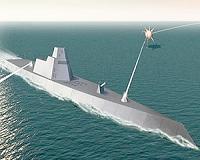 |
Arlington VA (SPX) Jan 27, 2011 Scientists at Los Alamos National Lab in Los Alamos, N.M., have achieved a remarkable breakthrough with the Office of Naval Research's (ONR) Free Electron Laser (FEL) program, setting the stage for a preliminary design review. Researchers demonstrated an injector capable of producing the electrons needed to generate megawatt-class laser beams for the Navy's next-generation weapon system Dec. 20, months ahead of schedule. "The injector performed as we predicted all along," said Dr. Dinh Nguyen, senior project leader for the FEL program at the lab. "But until now, we didn't have the evidence to support our models. We were so happy to see our design, fabrication and testing efforts finally come to fruition. We're currently working to measure the properties of the continuous electron beams, and hope to set a world record for the average current of electrons." Quentin Saulter, FEL program manager for ONR, said the implications of the FEL's progress are monumental. "This is a major leap forward for the program and for FEL technology throughout the Navy," said Saulter. "The fact that the team is nine months ahead of schedule provides us plenty of time to reach our goals by the end of 2011." The research is a necessary step for the Department of the Navy to one day deploy the megawatt-class FEL weapon system, revolutionizing ship defense. "The FEL is expected to provide future U.S. naval forces with a near-instantaneous laser ship defense in any maritime environment throughout the world," said Saulter. ONR's FEL project began as a basic science and technology program in the 1980s and matured into a working 14-kilowatt prototype. In fiscal 2010, it graduated from basic research to an innovative naval prototype, earning the backing needed by senior Navy officials to ensure its evolution to advanced technology and potential acquisition. The laser works by passing a beam of high-energy electrons generated by an injector, through a series of strong magnetic fields, causing an intense emission of laser light. ONR hopes to test the FEL in a maritime environment as early as 2018. ONR provides the science and technology necessary to maintain the Navy and Marine Corps' technological advantage. Through its affiliates, ONR is a leader in science and technology with engagement in 50 states, 70 countries, 1,035 institutions of higher learning and 914 industry partners. ONR employs approximately 1,400 people, comprising uniformed, civilian and contract personnel, with additional employees at the Naval Research Laboratory in Washington, D.C.
Share This Article With Planet Earth
Related Links US Navy Learn about laser weapon technology at SpaceWar.com
 US Office Of Naval Research Achieves Milestone
US Office Of Naval Research Achieves MilestoneArlington VA (SPX) Jan 21, 2011 Scientists at Los Alamos National Lab, N.M., have achieved a remarkable breakthrough with the Office of Naval Research's Free Electron Laser (FEL) program, demonstrating an injector capable of producing the electrons needed to generate megawatt-class laser beams for the Navy's next-generation weapon system. The Dec. 20 milestone, which occurred months ahead of schedule, will be the highlig ... read more |
|
| The content herein, unless otherwise known to be public domain, are Copyright 1995-2010 - SpaceDaily. AFP and UPI Wire Stories are copyright Agence France-Presse and United Press International. ESA Portal Reports are copyright European Space Agency. All NASA sourced material is public domain. Additional copyrights may apply in whole or part to other bona fide parties. Advertising does not imply endorsement,agreement or approval of any opinions, statements or information provided by SpaceDaily on any Web page published or hosted by SpaceDaily. Privacy Statement |